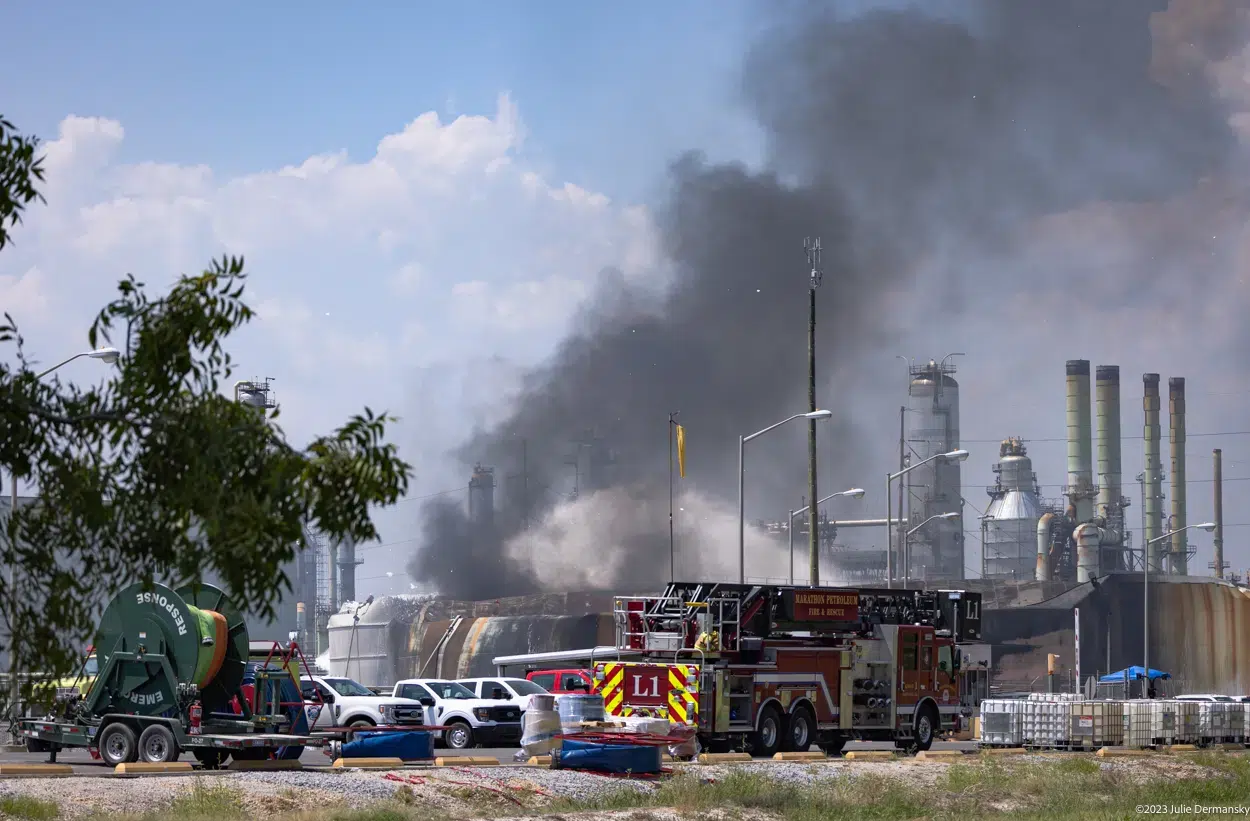When St. John the Baptist Parish residents woke up on Friday, August 25, they saw a plume of black smoke above the Marathon Petroleum refinery between Reserve and Garyville, Louisiana. Marathon told residents and parish officials that the fire started that morning around two tanks storing naphtha — a type of partially refined petroleum used as an ingredient in gasoline.
But the naphtha leak actually began at 6:50 p.m. Thursday, August 24, 15 hours before residents in the area were evacuated, according to a report to the National Response Center, the federal point of contact for reporting all oil and chemical spills. The Louisiana State Police were notified about half an hour later.
Naphtha is a colorless flammable mixture distilled from crude oil to make solvents and gasoline. Exposure to this kind of hydrocarbon mixture can cause headache, dizziness, nausea, and vomiting, according to the Centers for Disease Control and Prevention.
By 11:06 p.m., the Louisiana Department of Environmental Quality (LDEQ) was on the scene, according to documents reviewed by DeSmog, after being notified by Louisiana State Police. An initial air monitoring reading detected benzene, a known carcinogen, in the air, according to an LDEQ field interview document from the incident. Air monitor readings taken with a handheld gas monitor between 7:30 a.m. and 8 a.m. on Friday, August 25, detected additional volatile organic compounds, which can cause difficulty breathing, nausea, and damage to the central nervous system, according to an LDEQ air monitoring report.
Despite these dangerous leaks, no officials called for an evacuation for residents living within a two mile radius of the facility until 10:15 a.m. on Friday, during a press conference held by St. John the Baptist Parish President Jaclyn Hotard. Justin Lawrence, a human resources manager for Marathon, said at the press conference that the naphtha that leaked from the storage tanks caught fire around 7 a.m. Friday.
“Just tell the damn truth,” Anne Rolfes, founder of the environmental advocacy group Louisiana Bucket Brigade, told DeSmog. “This is what they do. They just fudge it all.”
When reached for comment, Marathon Petroleum and the Louisiana State Police had no response.
Attorneys with Wright and Gray, a law firm based in New Orleans, have filed a lawsuit against Marathon on behalf of residents who said they had respiratory and eye issues in response to the fire, attorney Daryl Gray told DeSmog.
CTEH ‘Never Finds Problems’
CTEH, an environmental consulting firm companies hire to perform environmental testing during industrial disasters, was also at the fire that Friday morning. CTEH has been accused of downplaying the danger of chemical and oil spills, including the February train derailment in East Palestine, Ohio, the 2010 BP oil spill, the 2005 Murphy oil spill following Hurricane Katrina, and when Texaco (now Chevron) was accused of dumping 18.5 billion gallons of toxic wastewater for years into the Ecuadorian rainforest.
“They called in a company who has made a long practice of never finding any problems,” Rolfes said. “This company has never found a problem and never will. And that is why Marathon called them.”
Louisiana’s air monitoring efforts did not begin until about 1:12 a.m. Friday morning, about six hours after the naphtha leak began, according to Wilma Subra, a Louisiana-based environmental scientist and toxics expert, who reviewed the LDEQ reports for DeSmog. “They didn’t start the monitoring for a good little while,” she said.
The reports indicate that the Marathon refinery storage tank held about 67,000 barrels of naphtha when the leak occurred. The company attempted to transfer the refined petroleum out of the leaking storage tank and into an alternative tank. But LDEQ’s notes do not say how much of the product was transferred before it burned. “I didn’t think they wrote it up well enough so you could really understand,” Subra said.
The National Response Center notified the federal Environmental Protection Agency (EPA) of the refinery fire at on Friday August 25, at 9:45 a.m., according to Joseph Robledo with Region 6 of the EPA. The agency activated its emergency response protocols, and deployed a federal on-scene coordinator to the site to oversee the response and provide technical support, including emergency response air monitoring in downwind communities, Robledo reported. He said EPA monitored for volatile organic compounds, benzene, hydrogen sulfide, and fine particulate matter, or PM 2.5. All detections were below the action levels of 1 part per million for volatile organic compounds, including benzene, and 300 micrograms per cubic meter for PM 2.5, he added.
LDEQ, the Environmental Protection Agency and CTEH conducted air quality monitoring inside and outside the Mt. Airy Math and Science Magnet School, an elementary school in Garyville within a two-mile radius of the refinery that was evacuated during the refinery fire, one report indicates. “Normal ambient air conditions [were] observed,” according to the LDEQ report.
Subra expressed concern for the community members who may have been exposed overnight and early the next morning to toxins in the air from the chemical spill. “They didn’t get them out of there quick enough,” she said. “It was going on overnight. They let the kids go to school.”
Subscribe to our newsletter
Stay up to date with DeSmog news and alerts







